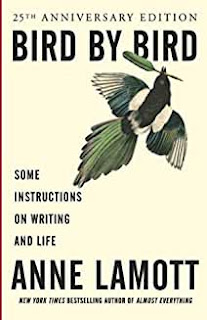A year after asking here on ABBA why I couldn’t find the right voice for my protagonist if I had his character arc broadly sorted out, and the overall plot laid down, today I can at least say that I’ve nailed his voice for now.
At one level, this is pathetic progress.
At another, writing anything at all is a win when life remains determined to lob a steady succession of curved balls in my family’s direction – which I guess is true for most of us these days: the abnormal and unpredictable are our daily lot.
Anyhow, the encouraging thought that all words are good words was offered to me this week by a dear writer friend, Eden Enfield, proving once again that writer buddies are the best.
Another set of writing comrades inspired this article.
A post-Arvon writing course group has been discussing Bird by Bird by Anne Lamott over on Slack recently. While singing its praises, I realised it had more wisdom to give years after I read it.
Hitherto, I had understood Lamott’s one-step-at-a-time philosophy in terms of writing: don’t look too far ahead; allow each scene to unfold and reveal itself.
Except that this system hasn’t worked for the work-in-progress, hence I’ve been stuck at a woeful word count for a shameful length of time.
So what birds if any have I ticked off in the past year?
Well, a distinct voice for both point-of-view characters. That’s proper progress. Back in the day, lots of editors and fellow writers said that voice was their starting point, and agents would say books were being bought and sold on the strength of voice alone.
I don’t know if that is still true today, if it ever was, but based on my experience with The Goose Road I came to the current story believing I could retrofit voice if necessary.
That turned out to be an error for a dual perspective narrative. The sameness of the first iteration of both voices ran counter to every bit of advice about writing in this format. My first reaction to this discovery (cut the second point-of-view character entirely) was a mistake, too.
I had to learn to embrace my intuitive knowledge that Beth’s voice is integral to this story, even if that meant finding a new way of working. As it turned out, developing distinctive voices for both Beth and Tom proved essential to the details of the plot and also determined the novel’s structure.
Which is another bird, right?
The third bird is a workable structure for a partly pre-determined plot. For this story, I am using the historical record as a map, choosing which landmarks to linger beside, but only straying from the facts when necessary.
That’s not the creative constraint it might appear to be since all the why questions about the characters remain, including the intriguing and perplexing worlds of seventeenth century beliefs, hopes, fears and desires. Which is a land I’m still exploring.
[I know. Stupidly slow, huh?]
Bird four is actually a small flock: three different synopses – and more in the pipeline – which have finally integrated my two plotlines, which had for months seemed so disparate they didn’t make a whole.
I also know the species of a fifth bird. Or perhaps I should say its genus. That is, the meta-message of the story, its underlying theme or controlling idea.
Lots of writing gurus whom I admire say we ought to wait for this bird to emerge naturally from our characters and plots – advice I accept in theory, but find I waste an awful lot of time with binoculars trained on the undergrowth, searching for it.
[Enough of the metaphor, yeah? I think it’s been done to death.]
So there we are. Five pillars of story that are becoming concrete one by one: plot, character, voice, structure and theme. I don’t recommend constructing a novel this way. It’s a bit back-to-front and demoralizing, to be honest. But that’s what’s happening. And that’s okay.
Hope you’re enjoying autumn.
Twitter @HouseRowena
Facebook Rowena House Author
Website rowenahouse.com




No comments:
Post a Comment